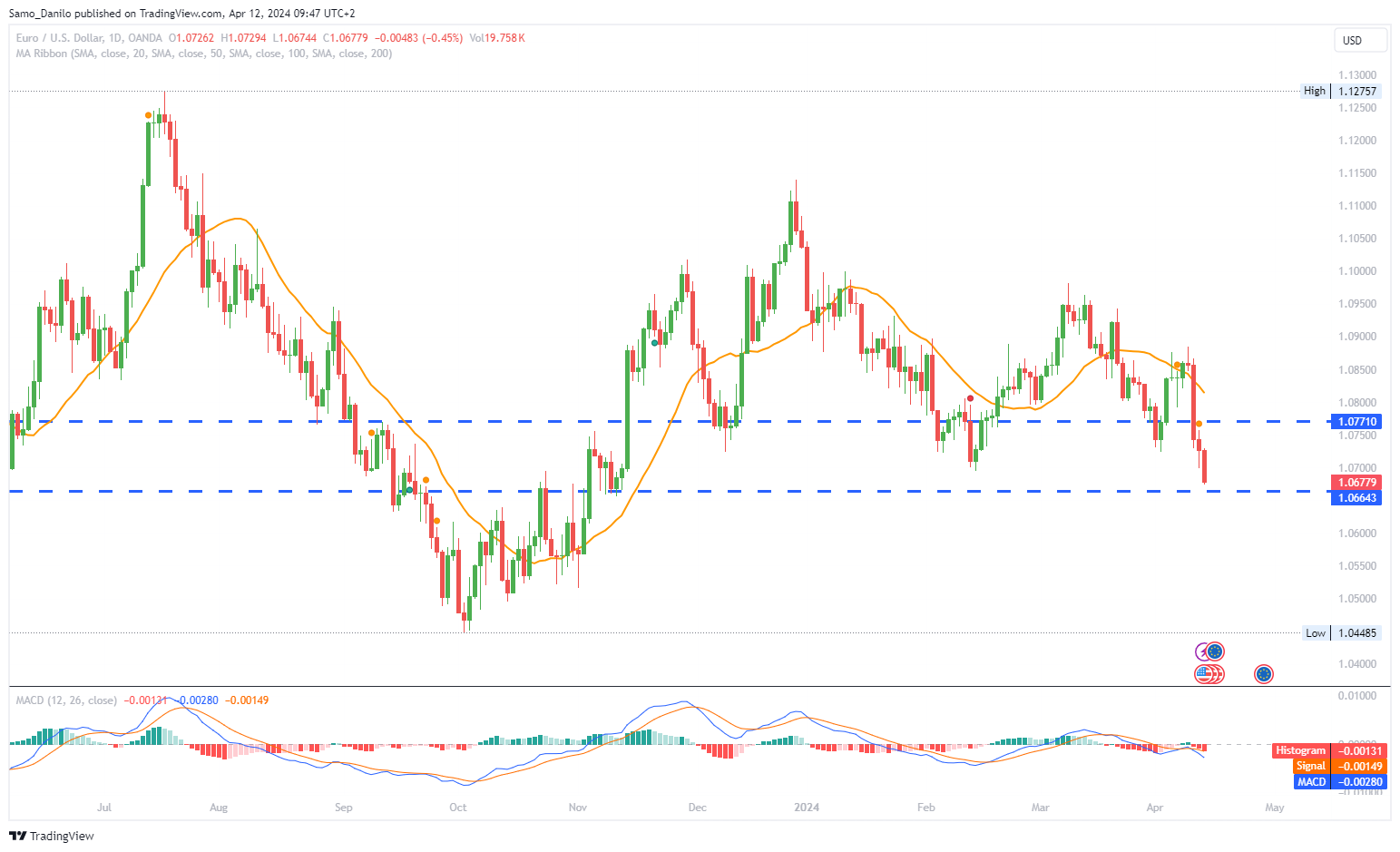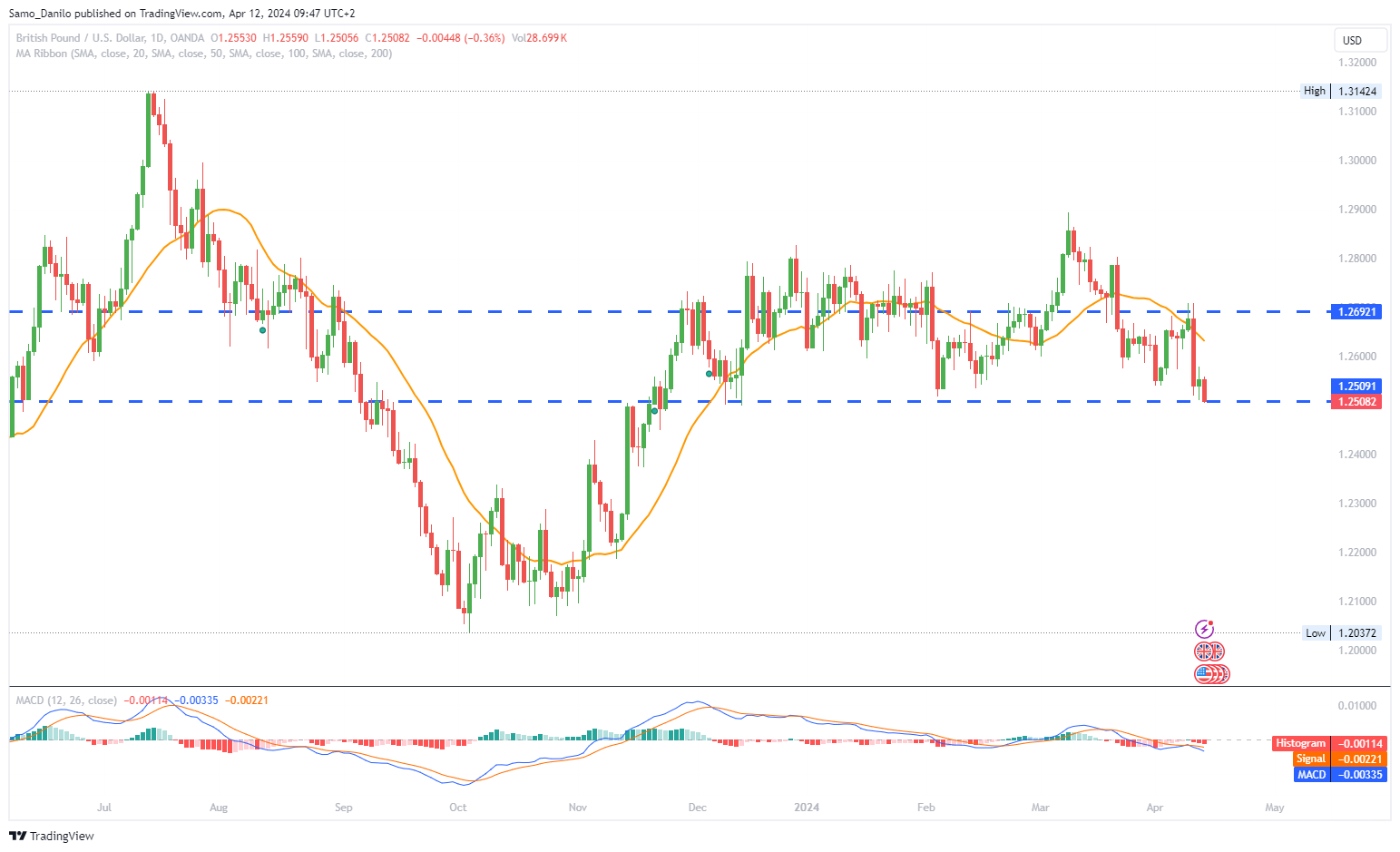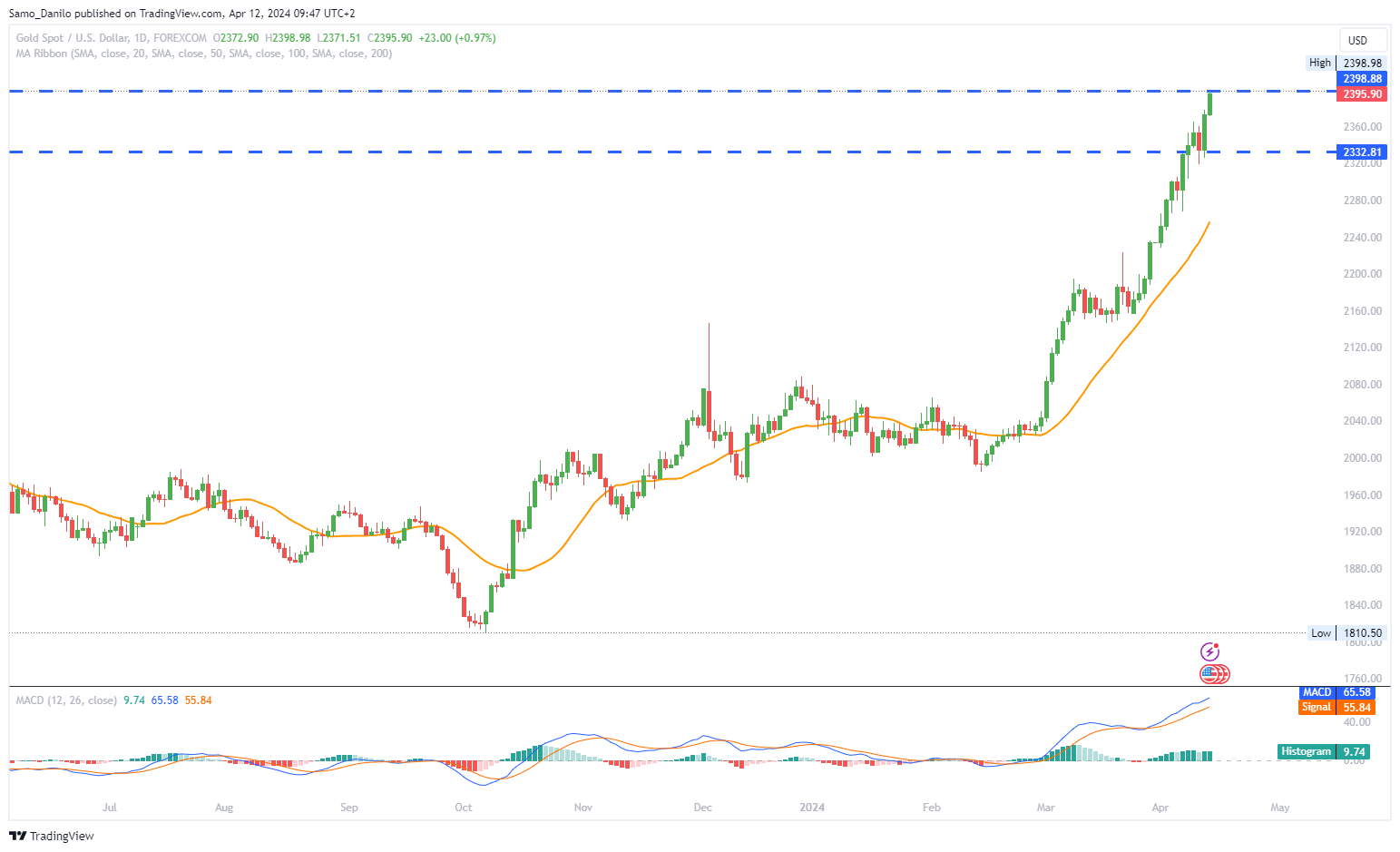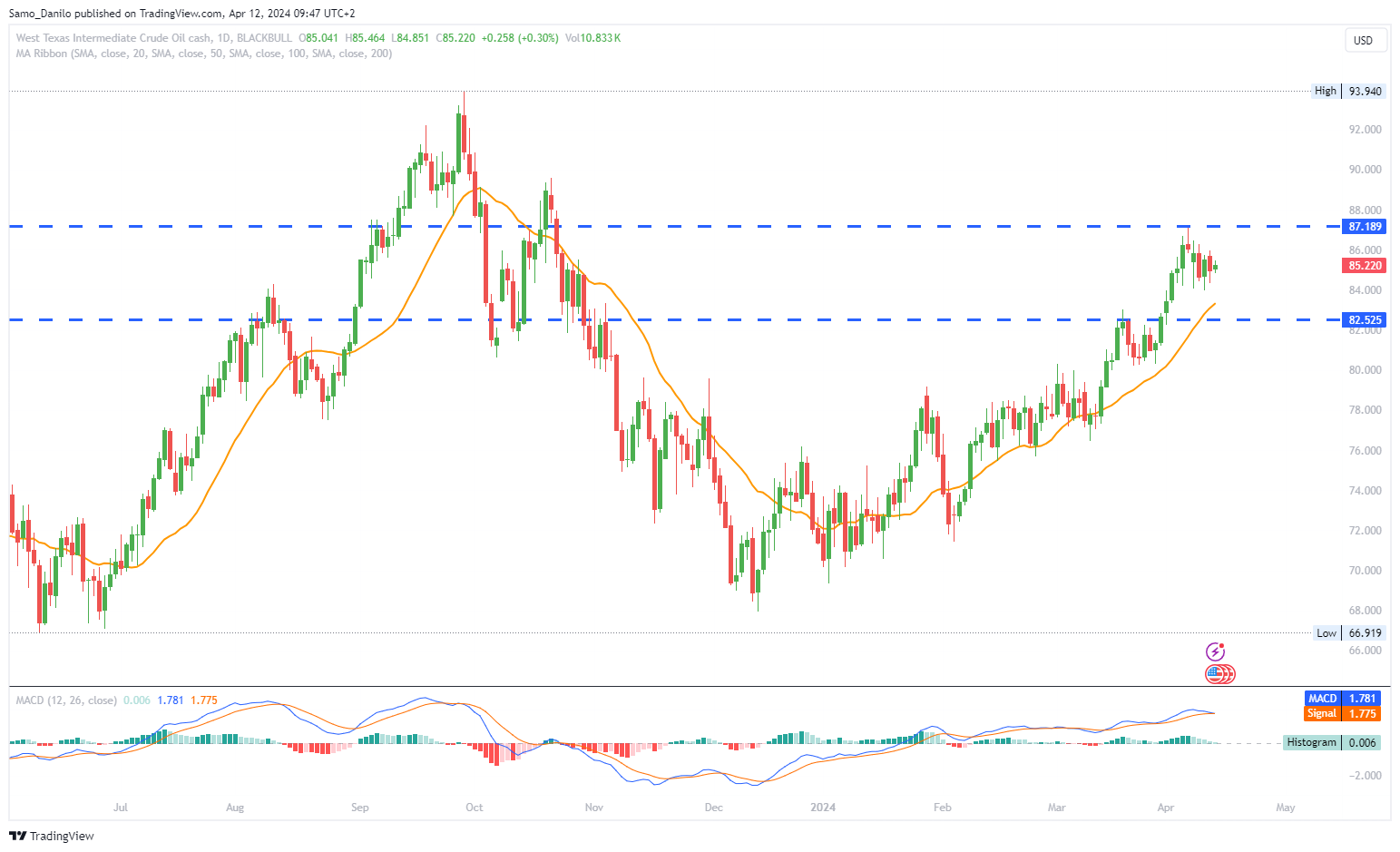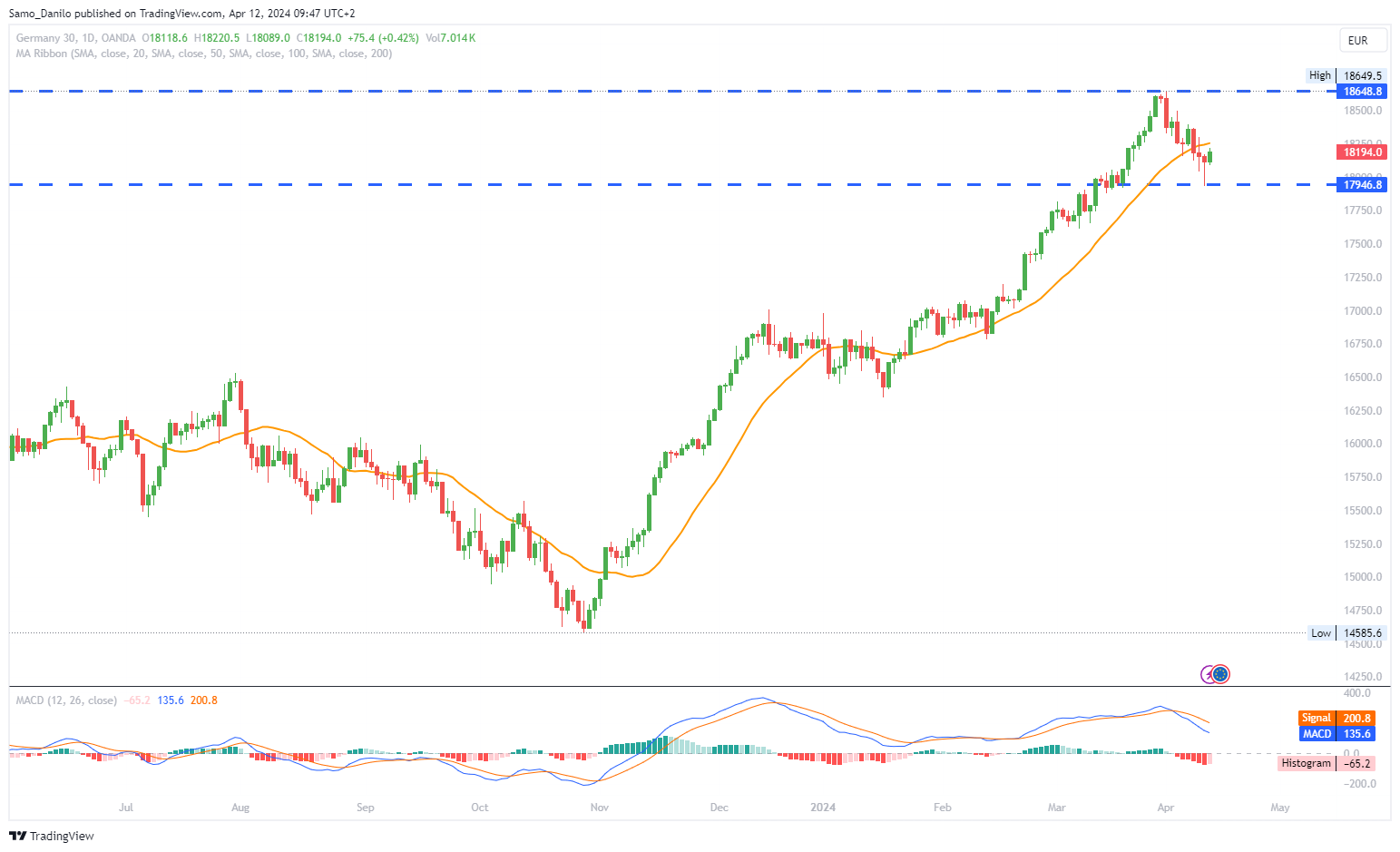EURUSD
- EUR/USD Movement: EUR/USD continues to face downward pressure, trading below the 1.0700 level during Friday's early Asian session. This suggests a bearish sentiment prevailing in the market.
- US Dollar Strength: The modest recovery in the US Dollar (USD) is weighing on the EUR/USD pair, driven by rising speculation of a Federal Reserve (Fed) rate cut in September. The prospect of higher interest rates in the US compared to the Eurozone may attract investors to the dollar, leading to a decline in EUR/USD.
- US Producer Price Index (PPI): Data on US inflation at the wholesale level for March came in softer than expected, with the Producer Price Index (PPI) rising by 0.2% month-over-month (MoM) instead of the estimated 0.3%. This has bolstered hopes for rate cuts by the Federal Reserve later this year, potentially weakening the US Dollar further.
- ECB Monetary Policy: The European Central Bank (ECB) held interest rates steady at a record high, in line with expectations. However, the ECB hinted at the possibility of a rate cut in June, signaling a dovish stance. This anticipation of monetary easing by the ECB may contribute to the weakness of the Euro against the US Dollar.
- Market Expectations: Market participants have priced in a 25 basis points (bps) rate cut from the ECB in June, based on data from the London Stock Exchange Group (LSEG). This suggests that investors are anticipating further monetary stimulus from the ECB, which could impact the exchange rate of EUR/USD.
Closing statement: EUR/USD remains under pressure below the 1.0700 level, driven by a modest recovery in the US Dollar and expectations of a Fed rate cut. Soft US inflation data and hints of monetary easing by the ECB further contribute to the bearish sentiment surrounding the pair.
GBPUSD
- GBP/USD Movement: The GBP/USD pair is trading defensively near the 1.2530 level during the early European trading hours on Friday. This suggests a cautious sentiment prevailing in the market regarding the Pound Sterling (GBP) against the US Dollar (USD).
- UK Economic Data: Recent data released from the Office for National Statistics revealed that the UK monthly Gross Domestic Product (GDP) grew by 0.1% month-over-month (MoM) in February. Additionally, UK Industrial Production for February surpassed market expectations, showing an improvement of 1.1% MoM, compared to a decline of 0.3% in January. Despite the positive economic indicators, the Pound Sterling failed to gain significant traction.
- Market Expectations: The upbeat UK economic data did not significantly boost the Pound Sterling, as the markets anticipate the Bank of England (BoE) to cut its interest rates sooner than the US Federal Reserve (Fed). This expectation of monetary easing by the BoE compared to the Fed could weaken the Pound Sterling against the US Dollar.
- US Economic Indicators: The recent hotter-than-expected Consumer Price Index (CPI) inflation reading and stronger Nonfarm Payrolls (NFP) data in the US have triggered speculation that the Fed may delay or adjust its plans for interest rate cuts this year. This could potentially strengthen the US Dollar against the Pound Sterling.
- Overall Sentiment: The combination of cautious market sentiment regarding the Pound Sterling and speculation surrounding the monetary policies of the BoE and the Fed suggests that the GBP/USD pair may remain under pressure in the near term.
| SMA (20) | Slightly Falling |
| |
| RSI (14) | Falling |
|
|
| MACD (12, 26, 9) | Slightly Falling |
|
Closing statement: the GBP/USD pair is trading defensively amid cautious market sentiment, despite positive UK economic data. Anticipation of monetary easing by the Bank of England and speculation regarding the timing of interest rate cuts by the Federal Reserve are key factors influencing the exchange rate dynamics between the Pound Sterling and the US Dollar.
GOLD
- Gold Price Movement: The price of gold is nearing yet another record high, approaching the $2,400 mark in Friday's Asian session. This indicates strong bullish momentum in the gold market, with investors showing significant interest in the precious metal. Investor Sentiment: Buying interest in gold remains robust, driven by ongoing geopolitical tensions, particularly between Israel and Iran. The escalation of tensions in the Middle East has prompted investors to seek refuge in gold, considering it as the ultimate traditional safe-haven asset.
- International Diplomacy: Recent diplomatic efforts involving Russia, Germany, and Britain aimed at urging restraint in the Middle East have provided some relief, albeit limited, to the gold market. However, the looming threat of an Iranian strike on Israel continues to contribute to the bullish sentiment surrounding gold.
- Impact of US Economic Data: Despite the pushback in expectations for a US Federal Reserve (Fed) interest rate cut from June to September following strong US Consumer Price Index (CPI) and Core Producer Price Index (PPI) data, gold price has remained resilient. This suggests that geopolitical concerns and safe-haven demand are currently outweighing the impact of economic data on gold prices.
- Central Bank Purchases: Gold price is also supported by increased purchases from global central banks, including those of Turkey, Kazakhstan, and China. Central banks' continued accumulation of gold reserves contributes to the overall bullish outlook for the precious metal.
| SMA (20) | Rising |
|
|
| RSI (14) | Rising |
|
|
| MACD (12, 26, 9) | Rising |
|
|
Closing statement: gold price is nearing record highs as investor interest remains strong amid geopolitical tensions and increased central bank purchases. Despite some diplomatic efforts to ease tensions in the Middle East, the overall bullish sentiment in the gold market persists, supported by ongoing geopolitical uncertainties and safe-haven demand.
CRUDE OIL
- Oil Price Movement: Crude oil prices are experiencing a decline today, influenced by concerns about elevated inflation, which has tempered expectations for US interest rate cuts this year. This downward pressure on oil prices reflects the broader market sentiment regarding monetary policy and its potential impact on economic growth and demand for oil.
- Market Expectations: Financial markets have adjusted their expectations for US interest rate cuts, with only two rate cuts anticipated for this year, likely to commence in September, according to the CME FedWatch Tool. This adjustment in rate expectations has contributed to the downward trend in oil prices, as investors reassess their outlook for global economic conditions and oil demand.
- EIA Report Impact: The decline in oil prices has been exacerbated by the release of the Energy Information Administration (EIA) report, which revealed a significant increase in crude oil stockpiles in the United States for the week ending April 5. The build-up in inventories signals potential oversupply concerns in the oil market, further pressuring prices downward.
- Geopolitical Risks: Despite the downward pressure on oil prices, geopolitical risks in the Middle East continue to influence market sentiment. Ongoing negotiations to resolve the Gaza war, along with the potential for a fresh round of conflict stemming from the Israeli - Iranian tensions, contribute to uncertainty in the region. These geopolitical tensions have the potential to disrupt oil supply routes and support oil prices.
- Iranian Threat: The looming threat of a potential Iranian strike on Israel, following a suspected Israeli air strike on its embassy in Syria on April 1, adds to the geopolitical risks in the Middle East. This geopolitical uncertainty serves to mitigate the downside of oil prices, as market participants remain wary of potential supply disruptions and regional conflicts.
| SMA (20) | Rising |
|
|
| RSI (14) | Slightly Rising |
| |
| MACD (12, 26, 9) | Rising |
|
|
Closing statement: crude oil prices are declining today due to concerns about elevated inflation and tempered expectations for US interest rate cuts. The release of the EIA report showing a significant increase in US crude oil stockpiles further adds to the downward pressure on prices. However, ongoing geopolitical risks in the Middle East, including negotiations to resolve the Gaza war and the potential for conflict between Israel and Iran, continue to underpin oil prices, mitigating their decline.
DAX
- ECB Interest Rate Plans: On Thursday, the European Central Bank (ECB) signaled its intention to cut interest rates, despite diminishing expectations for a rate cut by the Federal Reserve (Fed) in June. However, investor sentiment regarding the Fed's rate trajectory remained a hindrance to market sentiment.
- Inflation Focus: Inflation remained a key focus on Thursday, with attention on US producer price data for March. The numbers indicated a persistent outlook for consumer price inflation, as producer prices rose by 2.1% year-on-year, following a 1.6% increase in February. These inflationary pressures have implications for monetary policy decisions and market expectations.
- ECB Survey of Professional Forecasters: On Friday, investor attention will once again turn to the ECB, with the ECB Survey of Professional Forecasters expected to provide insights into economic forecasts and expectations. This survey is closely monitored by market participants for indications of future ECB policy actions.
- ECB Commentary: Additionally, investors should pay attention to commentary from ECB Executive Board Members Luis de Guindos and Frank Elderson, as their remarks could offer further insights into the ECB's policy stance and outlook for the eurozone economy.
- Michigan Consumer Sentiment Index: On Friday, preliminary Michigan Consumer Sentiment numbers will be released, drawing investor interest. Economists anticipate a slight decline in the Michigan Consumer Sentiment Index from 79.4 to 79.0 in April, which could impact market sentiment and expectations for consumer spending and economic growth.
| SMA (20) | Rising |
|
|
| RSI (14) | Falling |
|
|
| MACD (12, 26, 9) | Falling |
|
|
Closing statement: market focus on the DAX index is influenced by ECB interest rate plans, inflation data, ECB surveys and commentary, and consumer sentiment indicators. These factors collectively shape investor sentiment and market expectations for economic growth and monetary policy, impacting the performance of the DAX index.
